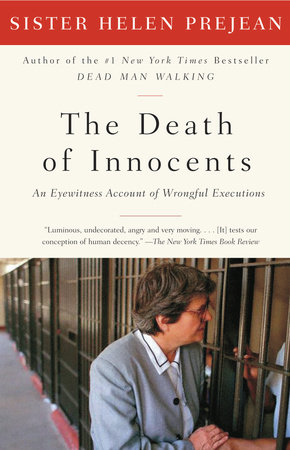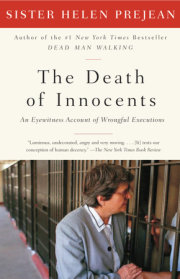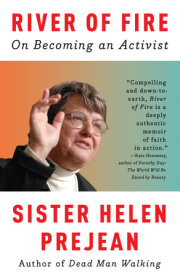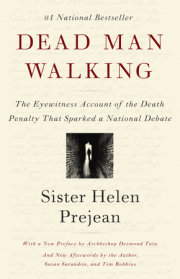Chapter One
Dobie Gillis Williams
When I first met him I was struck by his name, Dobie Gillis, and then when I heard he had a brother named John Boy, another TV character, I knew for sure his mama must like to watch a lot of TV. Betty Williams, Dobie Williams’s mama, is here now in the death house of the Louisiana State Penitentiary, a terrible place for a mama to be. It’s January 8, 1999, at 1:00 p.m., and she’s here with family members, two of Dobie’s lawyers, and me, his spiritual adviser, and we’re all waiting it out with Dobie to see if the state is really going to kill him this time.
Dobie’s had eleven execution dates since 1985 and close calls in June and November when the state came within a couple of hours of killing him but had to call it off because of last-minute stays of execution. I feel this is it, they’re going to get Dobie this time, and I’m praying for courage for him and for his mama and for me, too. I’ve done this four other times,1 accompanying men to execution, first with Patrick Sonnier in 1984, walking through this very room on his way to the electric chair, and here we are sitting with Dobie, hoping against hope he won’t have to make that walk through this room tonight. His execution by lethal injection is scheduled for 6:30. About five hours to go.
Dobie’s death is set to conclude a story that began more than fourteen years before, in the early morning hours of July 8, 1984. It was then that forty-three-year-old Sonja Merritt Knippers was stabbed to death as she sat on the toilet in her bathroom in Many, Louisiana, a small town in north central Louisiana. Mrs. Knippers’s husband, Herb, who said he was in the bedroom during the slaying, told investigators that he heard his wife yelling, “A black man is killing me,” which led police to round up three black men, Dobie Gillis Williams among them. He was home on a weekend furlough from Camp Beauregard, a minimum-security detention facility, where he was serving a term for burglary. He had been allowed the visit because he was a model prisoner, not prone to violence.
At 2:30 a.m., police officers seized Dobie, asleep on the couch at his grandfather’s house, brought him to the police station, and began interrogating him. They told him that they would be there for the rest of the night and all morning and all the next day if need be, until they “got to the bottom of this.” Three police officers later testified that Dobie confessed, and at the crime scene investigators found a bloodstain on a bathroom curtain, which the state crime lab declared was consistent in seven categories with Dobie’s, and statistically, that combination would occur in only two in one hundred thousand black people. Investigators also found a “dark-pigmented piece of skin” on the brick ledge of the bathroom window, through which the killer supposedly entered and escaped.
Dobie’s trial didn’t last long. Within one week, the jury was selected, evidence presented, a guilty verdict rendered, and a death sentence imposed.
Now, waiting here in the death house, I pray. No, God, not Dobie. I’ve been visiting him for eight years. He’s thirty-eight years old, indigent, has an IQ of 65, well below the score of 70 that indicates mental retardation. He has rheumatoid arthritis. His fingers are gnarled. His left knee is especially bad, and he walks slowly, with labored steps. He has a slight build, keeps his hair cropped close, and wears big glasses, which he says gives him an intellectual look. His low IQ forces him to play catch-up during most conversations, especially if he is in a group.
Earlier today, Warden Burl Cain asked Dobie if he wanted to be rolled to the death chamber in a wheelchair. “Dobie, we’ll do it your way, any way you want, so if you want the wheelchair, we’ll do that. It might make it easier on you, but if you want to walk, I mean that’s okay, too, no matter how long it takes. We’ll just go at your pace. If it takes a half hour, whatever it takes, it’s up to you, you can have it your way, like at Burger King, have it your way, and we’ll do anything you want to do.”
Dobie narrowed his eyes. “No way. I’ll walk.”
Later he says, “Man! Is he crazy? Let them people use a wheelchair on me? Man! No way. No way.”
The wheelchair is a sensitive issue. When Dobie got rheumatoid arthritis five years ago, his proud, fit body left him. Some of the guys on the Row started calling him “stiff,” and when they’d see a crippled person on TV, there’d be snickers as somebody yelled out, “Who does that remind you of?” Dobie would be silent in his cell.
“I just ignore them,” he’d tell me.
I notice how fast and soft and friendly the warden talks to Dobie. Of course he wants Dobie to use the wheelchair. I can tell he wants the process to go quickly so he and the Tactical Unit—the team responsible for the physical details of killing Dobie—can get it over with as soon as possible. Dobie, it is turning out, is proving difficult in several ways. There had been the last-minute stays of execution in June and November, which meant that the Tac team, Mrs. Knippers’s family members, the executioner, the support staff, the medical staff, and the ambulance crew that removes the body—all these people had to come back and go through it again, which is hard on everybody. Plus, Dobie rejected the offer to eat his final meal with Warden Cain as two other executed prisoners had done. That must have felt like a slap in the face, because the warden felt he was doing his best to show Christian fellowship to these men before they died.
The meal with the other condemned men—Antonio James and John Brown—had gone well, with clean white tablecloths and the menu and guests selected by the prisoner—lawyer friends and spiritual advisers—along with the guests the warden himself invited—a couple of friendly guards and Chaney Joseph, the governor’s attorney (who formulated the state’s current death penalty statute and stands ready to block any legal attempt to halt an execution). At these final meals they had all held hands and prayed and sung hymns and eaten and even laughed, and one of these scenes was captured on ABC’s Primetime Live when a story was done about Antonio James. In the Primetime piece, there at the head of the table was Warden Cain, like a father figure, providing the abundance of the last meal—boiled crawfish—making everything as nice and friendly as he could, even though when the meal was done the inevitable protocol would have to be followed and, as warden, he would be obliged to do his job. In the chamber, he’d nod to the executioner to begin injecting the lethal fluids into the arm of the man whose hand he was holding and with whom he was praying.
The warden is fond of quoting the Bible, and the verse he quotes to justify state executions is Paul’s Epistle to the Romans, chapter 13, which states that civil authority is “the servant of God to execute wrath on the wrongdoer.” Yes, this distasteful task laid on his shoulders is backed up by God’s word, which he tries hard to follow because he takes very seriously the eternal salvation of every man in this prison entrusted to his care. Warden Cain would do anything to avoid carrying out the death penalty, but it goes with the territory of being warden, and he likes being warden and is only a few years from retirement. So he goes along reluctantly and tries to be as nice to the condemned and their families as he can.
He could do what Donald Cabana, the former warden of Parchman Penitentiary in Mississippi, did. Warden Cabana quit his job because his conscience wouldn’t allow him to participate in executions. In his book, Death at Midnight: The Confession of an Executioner, he tells of presiding over the execution of two men in the gas chamber at Parchman. The second one, that of Connie Ray Evans, really got to Cabana because he liked the man, and they talked often and long. He tried truthfully to answer Connie Ray’s questions about how best to deal with the gas when it came, telling him to breathe deep, that it would be over faster that way.2 Then, after watching the dying man gasp for breath and twitch and strain against the straps in the chair, Warden Cabana quit the job, and today he gives lectures against the death penalty to anyone who will listen.
Warden Cain could choose to do that. He has confided to one of Dobie’s defense attorneys that he draws the line when it comes to women. Louisiana has one woman on death row, Antoinette Frank, and the warden says, no, he just couldn’t execute a woman, that he’ll quit before he does that. I wonder if he realizes that he’s the first trigger of the machinery of death—he nods and a man dies. The death certificate states the true nature of the deed: “Cause of death: homicide.” Maybe there’s a qualifying word, “legal,” but it’s homicide all the same.
When Dobie turned down the warden’s invitation to share his last meal, he said, “I ain’t going to eat with those people. It’s not like, you know, real fellowship. When they finish eating they’re going to help kill me.” He is the first one up for execution who’s turned down the warden’s invitation, and I’ve heard through the prison grapevine that the men on the Row respect him for it.
We’re all sitting around a table with Dobie in the death house visiting room: Jean Walker, Dobie’s childhood sweetheart; his mama; his aunt Royce; his brother Patrick; his four-year-old nephew, Antonio; two lawyer friends, Carol Kolinchak and Paula Montonye; and me. Dobie’s mama has her Bible open and puts her hand on it, saying, “No, not this time, either, they’re not going to kill you, Dobie, because in Jesus’s name I’ve claimed the victory, oh yes, in faith I claim the victory because God’s in charge, not man, God is the lord of life and death, and in Him is the victory, and you must believe, Dobie, you must trust, as the psalm says, Oh, God, you are my rock. Do you believe, Dobie, are you trusting God to bring you through this? Do you have faith?”
Her words are strong and urgent, and they shore her up against this dark and dreadful process. She is trying to infuse the spiritual strength she feels into her son, who says softly, “Yeah, Mama, I believe.”
“Say it like you mean it, Dobie, say it with conviction.”
“Yeah, Mama, I believe, I do.”
Dobie sits close to Jean, now back in his life after twenty or so years. She’s declared herself “strong in the Lord” and has her husband’s approval for these visits. She wants Dobie to be “strong in the Lord,” too. She heard about Dobie’s pending execution and reappeared in his life a few weeks before his June death date some eight months ago, and he can’t stop touching her. During earlier visits in the death row visiting room—not now—he was like a playful teenage boy, sitting close to her, pinching her arms, thumping her head, teasing her, coaxing, telling her how cute her smile and her eyes were. When his mama had enough of it and told him to leave her alone, he smiled and said, “I just like to pick at her.” His mama would open the Bible, read a passage, and press him for the meaning. Sometimes she would read lengthy passages and Dobie would say, “Not so long, Mama. Pick a short one. I just want to visit.”
My faith doesn’t give me the same assurance Dobie’s mama feels that he won’t be killed tonight. I’m praying that God will give him the strength and the courage he needs to overcome fear. Dobie’s been telling me how the fear eats at him. He was glad when Jean brought him a black baseball cap with the words of Isaiah, “Fear Not,” embroidered in white letters on the front. Prison rules forbid prisoners to wear hats with any sort of logo, but the guards let the “Fear Not” hat slide. Dobie’s worn it for three solid weeks except in the shower, and he wanted badly to wear the hat here in the death house, but the guards took it away when he was brought in at 9:30 this morning. “Man,” he says, stretching out the last part of the word, “mannnn, they won’t even let me have my hat.” It’s one more disappointment, but he tucks it somewhere inside, because after fourteen years of living in the “waiting to die” place, he’s used to holding himself in check and not wishing too hard for anything.
Dobie is sitting at the end of the table with his back to the window, through which you can see one of the two guards with automatic weapons guarding the front door. With the lagoon outside and the flowers in pots near the front entrance, you’d never know this is a building where people are put to death. And when you’re inside, all you see is a room with tables and chairs, two vending machines, and at the far end a white metal door. Behind this door, always kept locked, is the black cushioned gurney and the witness room with two rows of plastic chairs. Everything is neat and painted fresh and clean, the gray floor tiles polished and gleaming. The warden has had two large murals painted on the walls of this room, one of Elijah being taken up to heaven in a fiery chariot and the other of Daniel in the lion’s den, the lions with yellow, glinting eyes and Daniel looking upward toward an opening from which heavenly light pours. In the scripture stories, both men escaped death. Elijah was taken up to heaven alive in the chariot, and Daniel, through God’s power, persuaded the lions not to eat him. I sense in the murals an effort to make this a holy place, a place that’s not really so bad, because here you get to go to God.
This is a place where everything is run by protocol. Each step of the execution process has been carefully chiseled out. “Here’s what we do if he goes peacefully. Here’s what we do if he fights us. Okay, now, when we get in the room, I strap the legs, and you, the chest, and you, the right arm.” Everybody knows his part in the ritual. The Tac team has practiced over and over, so when it comes to the real thing they can do what they have to do. Plus, they’re bolstered by the law, by general popular support for the death penalty, and by the knowledge that all the courts in the land and the U.S. Congress say it’s constitutional to do the deed they’ll be doing tonight. Sometimes even the prison chaplains give their blessing to the act, backing it up, of course, with a quote from the Bible.
Copyright © 2004 by Helen Prejean. All rights reserved. No part of this excerpt may be reproduced or reprinted without permission in writing from the publisher.








